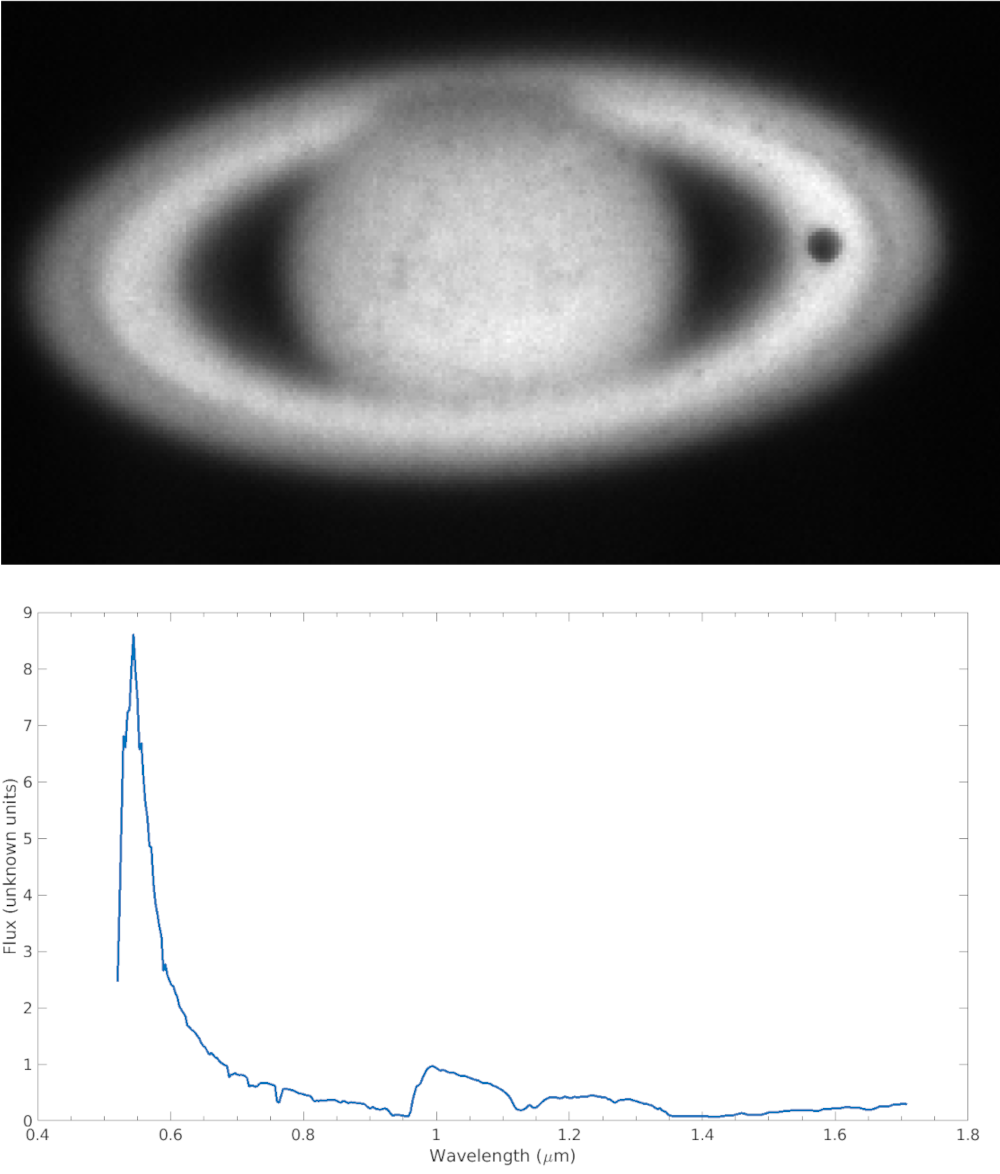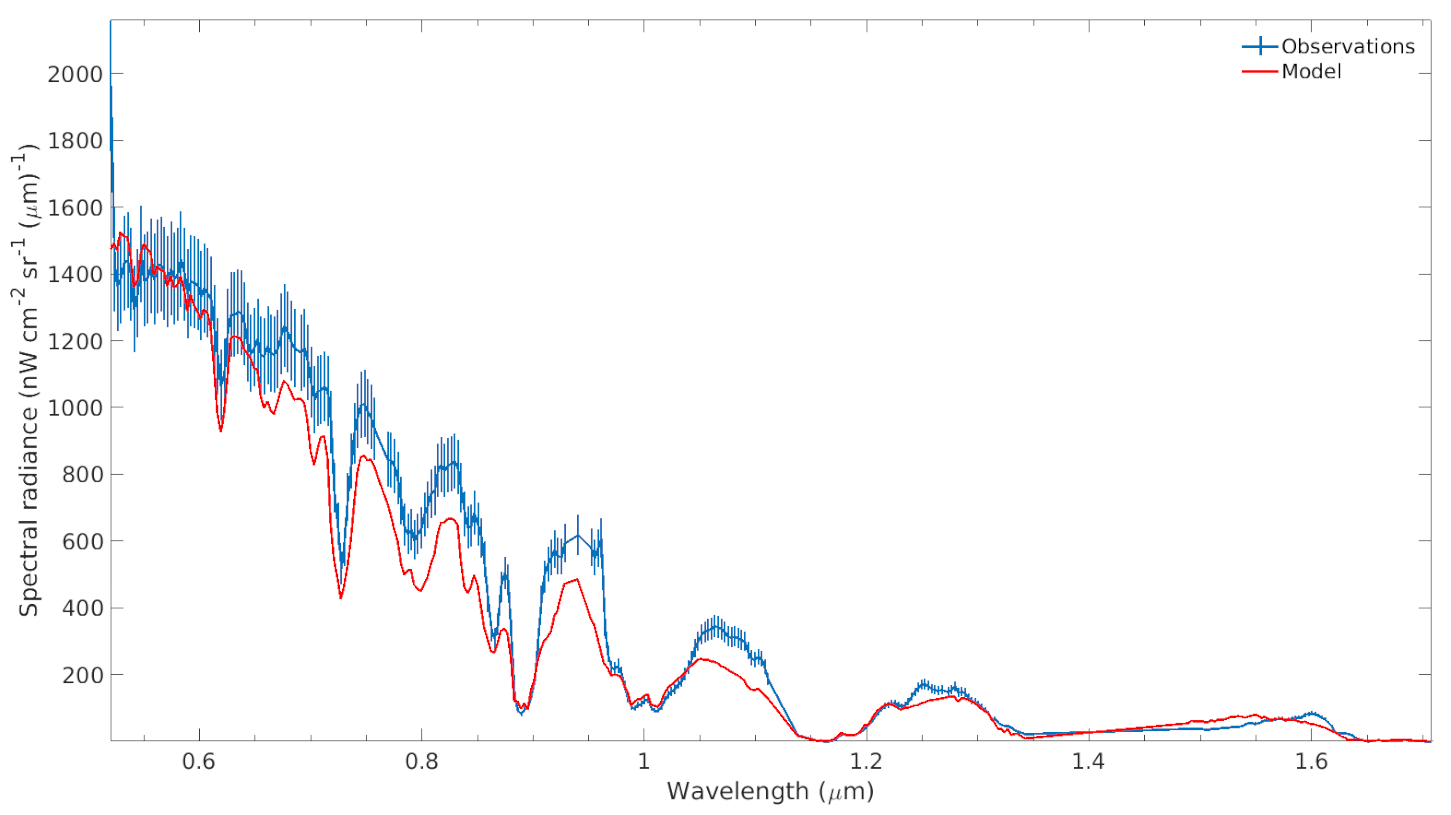Retrieving Jovian aerosol properties from CARMENES spectra: exploratory results
- 1Faculdade de Ciências da Universidade de Lisboa, Instituto de Astrofísica e Ciências do Espaço, Lisbon, Portugal (jlribeiro@fc.ul.pt)
- 2Escuela de Ingeniería de Bilbao, Universidad del País Vasco-Euskal Herriko Unibertsitatea, Bilbao, Spain
- 3Atmospheric, Oceanic, and Planetary Physics, Clarendon Laboratory, University of Oxford, Oxford, UK
There is still some debate on the origin and distribution of Jupiter’s red colouration. Based on the red compound obtained in a laboratory by Carlson et al. (2016)[1] through the reaction of photolysed ammonia with acetylene, Stromovsky et al. (2017)[2] proposed the idea of a “universal chromophore” which was able to fit observations with Cassini/VIMS-V. Baines et al.(2019)[3] later concluded that the chromophore would be located in a thin layer above the ammonia clouds, which was known as the “Crème Brûlée” model. However, other models propose a different scheme, with a more extended and less blue absorbing chromophore layer, such as Pérez-Hoyos et al. (2020)[4] for a North Temperate Belt disturbance and Braude et al. (2020)[5] for the overall latitudinal structure, even without discarding the possible existence of a universal chromophore. More recently, Aguiano-Arteaga et al. (2023)[6] analysed HST/WFC3 images of Jupiter’s Great Red Spot, as well as its surroundings and the Oval BA. Their results suggest the presence of two colouring aerosols, one very similar to the “universal chromophore” proposed by Stromovsky et al. (2017)[2] and a new colouring species at tropospheric levels, below the main chromophore layer. This highlights that there is still some uncertainty on how the aerosols are vertically distributed and their properties as well as the temporal and spatial variability, which, at last instance, is linked to the unknowns related to the formation and the nature of the absorbing particles and their chemistry.
In this work, we analysed Jupiter spectra obtained for the first time with CARMENES in Calar-Alto in 2019. The Calar Alto high-Resolution search for M dwarfs with Exoearths with Near-infrared and optical Échelle Spectrographs is an instrument operating at the 3.5m telescope at the Calar Alto Observatory. It consists of two separated spectrographs covering the wavelength ranges from 0.52 to 0.96 µm and from 0.96 to 1.71 µm with spectral resolutions R = 80,000-100,000, each of which performs high-accuracy radial-velocity measurements (∼1 m s⁻¹) with long-term stability. While the observations in this work were taken for Doppler velocimetry purposes, we used here a downgraded resolution version (R = 173-570) so the observations match the available spectral data for methane, the dominant gaseous source of opacity in the Jovian spectra.
To achieve flux calibration, 2017 first-time observations of Saturn with CARMENES were used, in particular, the observations of Saturn’s B ring (Figure 1). We used these to obtain the response function of the instrument, no other sources of calibration being available at the desired resolution. We used the spectrum of Saturn’s B ring in terms of absolute reflectivity (I/F) from Poulet et al. (2003)[7] as the flux calibrator to calculate the response function. We checked the flux calibration and its uncertainty comparing with the normalized albedo spectrum of Saturn from Karkoskcha (1994)[8]. Lastly, we applied the flux calibration to the Jupiter observations and compared them with MUSE/VLT Jupiter observations from Braude et al. (2020)[5].
For this analysis, we used the NEMESIS (Nonlinear Optimal Estimator for MultivariatE Spectral analySIS) radiative transfer suite (Irwin et al., 2008 [9]). This tool allows coverage of both reflection and emission from any planetary atmosphere in scattering and non-scattering environments. The code utilizes an optimal estimator method (Rodgers, 2000) [10] to find the best plausible values of the parameters that define the atmospheric model, with an a priori parametrization of the atmosphere and the observational uncertainties as the starting point. Our goal is to retrieve aerosol properties from the Jovian atmosphere using the NEMESIS radiative transfer suite, in order to constrain the cloud and aerosol vertical distribution as well as the chromophore(s) properties that give Jupiter its reddish colouration in some bands and storms. In particular, we want to compare different competing vertical models, with an extended or concentrated chromophore layer. For doing so, we used spectra from both the centre of the disk as well as near the limb in order to highlight the effects of the aerosols when Jupiter is observed from various viewing angles. We present here our first exploratory results from this analysis.

Figure 1: One of the CARMENES guiding camera images and visible and NIR spectra of Saturn's B ring used for flux calibration

Figure 2: First model spectrum obtained (red) when compared with the observations (blue) after retrieving two aerosol density profiles.
References:
-
Carlson, R. W., et al. (2016). Chromophores from photolyzed ammonia reacting with acetylene: Application to Jupiter's Great Red Spot. Icarus, 274, 106–115.
-
Sromovsky, L. A., et al. (2017). A possibly universal red chromophore for modeling color variations on Jupiter. Icarus, 291, 232–244.
-
Baines, K. H., et al. (2019). The visual spectrum of Jupiter's Great Red Spot accurately modeled with aerosols produced by photolyzed ammonia reacting with acetylene. Icarus, 330, 217–229.
-
Pérez-Hoyos, S., et al. (2020). Color and aerosol changes in Jupiter after a North temperate belt disturbance. Icarus, 132, 114021.
-
Braude, A. S., et al. (2020). Colour and tropospheric cloud structure of Jupiter from MUSE/VLT: Retrieving a universal chromophore. Icarus, 338, 113589.
-
Anguiano-Arteaga, A., et al.(2023). Temporal variations in vertical cloud structure of Jupiter's Great Red Spot, its surroundings and Oval BA from HST/WFC3 imaging. Journal of Geophysical Research: Planets, 128, e2022JE007427.
-
Poulet, F., et al. (2003). Compositions of Saturn's rings A, B, and C from high resolution near-infrared spectroscopic observations. A&A, 412, 1, 305–316.
-
Karkoschka, E. (1994). Spectrophotometry of the Jovian Planets and Titan at 300- to 1000-nm Wavelength: The Methane Spectrum. Icarus, 111, 1, 174–192.
-
Irwin, P., et al. (2008). The NEMESIS planetary atmosphere radiative transfer and retrieval tool. J. Quant. Spectrosc. Radiat. Transf., 109, 1136–1150.
-
Rodgers CD. (2000). Inverse methods for atmospheric sounding: theory and practice. Singapore: World Scientific.
How to cite: Ribeiro, J., Machado, P., Pérez-Hoyos, S., and Irwin, P.: Retrieving Jovian aerosol properties from CARMENES spectra: exploratory results, Europlanet Science Congress 2024, Berlin, Germany, 8–13 Sep 2024, EPSC2024-630, https://doi.org/10.5194/epsc2024-630, 2024.